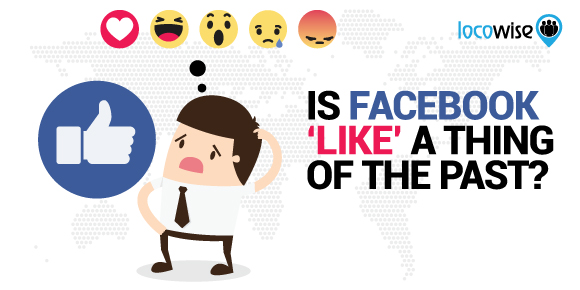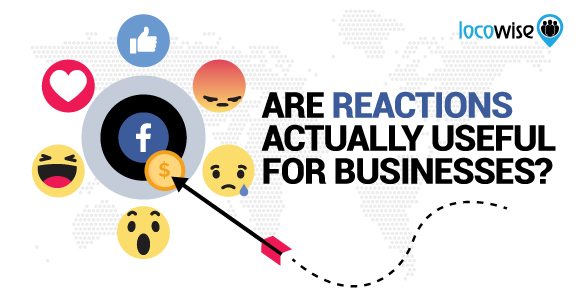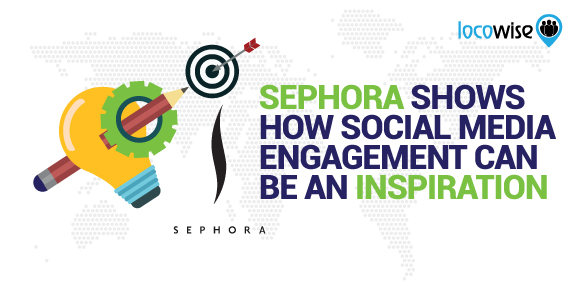Is Facebook Like A Thing Of The Past?
Sahail Ashraf posted on 15 March 2017
Facebook has been around for a long time now, and has undergone a multitude of changes and updates.
Since the early days when Facebook was nothing more than an amusing distraction, it has grown into a seriously powerful marketing tool. But for a long while, one of its most iconic features stayed put, and never changed.
When we ‘like’ something on Facebook, we boost its popularity.
That was the general feeling at the start of the Facebook phenomenon and still, even now, businesses are frantically encouraging customers to ‘like’ their page, because it ostensibly helps with marketing.

Like all things on social media, this has changed. When ‘Reactions’ were released unto the world last year, they immediately showed users that functionality (and responses) needn’t be constrained to simply liking something. And things have kind of come full circle now, with Likes being overtaken by the use of Reactions as a filter in the algorithm.
The Implications
Well, Facebook has essentially said it is going to prioritise reactions a bit over likes when ranking stories in news feeds of the users. And that’s it. So all of those campaigns you have been running for clients with that call to action to ‘like’ a post will now literally seem like the good old days. Reactions are what Facebook feels make more sense when ranking posts.
There is some good reasoning behind this and if you look at the whole thing logically it actually does make sense. The reactions experience allows for something other than you liking something. The reactions probably came about because so many people; (apparently) wanted to see a ‘dislike’ button. Of course, this could have led to all sorts of new kinds of trolling, so reactions came in instead.
And reactions also had the added benefit of actually creating more engagement. Put It this way, if likes were all that an audience had to respond to posts, everything would seem a little bit general. Bringing the audience on Facebook the opportunity to express feelings makes it a much better place, at least for the users.
But for businesses, the way forward was never that clear. Are reactions actually useful for businesses? Do the reactions give brands more information about the audience.
Well… yes. Reactions allow businesses to gain a clearer picture of what their audience thinks, and perhaps more importantly, which type of post resonates the most with them. The classic example of this is the ‘ha ha’ reactions, which shows that someone found your post funny. If you get these reactions every time you post funny stuff, or even stuff that is just to make people smile, you will know a little bit more about your audience. Test it by posting something serious such as a bit of news. Run both types of post alongside each other (serious and funny) and see which get the most reactions. As a tool for gauging an audience’s preferred content, reactions are another weapon in your arsenal.

Your metrics are your friend here. Use tools such as Locowise to understand the sentiment of your users, to identify which reactions get used the most and what type of content gets what type of a reaction. This way, you can test and test again, to eventually come to place where you know what your audience on Facebook genuinely likes (as opposed to ‘Likes’).
And for businesses?
If you have a client that features heavily on Facebook and a lot of work has gone into this, you could be forgiven for thinking that Facebook has basically made all your hard work gaining likes redundant. But that isn’t the case, and there are a few ways in which you can use reactions to your advantage.
One thing you could do is ask your audience to pick a reaction for a product launch, or an aspect of your service. If you run a restaurant, for example, ask people to offer reactions to a particular dish. You will most likely gain a few responses, but the engagement levels should be better, due to the opinion aspect of the process.
And if you are running a competition or contest, you can put reactions to good use there too. Make a contest happen, and then only allow people to enter through giving a reaction. This again builds up engagement and also gives you a better handle on how reactions are working for your client’s brand.
What’s really interesting here, a year after the birth of Reactions, is how brands can tailor the content to meet certain Reactions, and see if the content serves that purpose. It’s not as simple as it seems, but if it is done well, and with preparation beforehand, it’s not that far from starting a movement.

For example, if you have a post or update that you know will provoke a reaction, such as something that goes against your principles as a brand (as well as your audience’s) you could post it up and encourage people to offer their reactions. Essentially, you’re creating content that you know will affect your audience, and if it is tied into your own ethos and mission, you are creating content that is more ‘engagement ready’.
Love, Haha, Wow, Sad and Angry and… Like?
That’s right, Like is still there, but the Reactions are too. Facebook is creating a social media arena that allows for more complex responses to posts. And visual communication is accessible to anyone in any language.
Have fun with them, and if you’re not using them yet in your campaigns, this is the perfect time to see how they work. And don’t forget, you can ask an audience to offer a Reaction.
Facebook Likes are not old news then, but just part of a family of emotions and responses that allow for even more engagement and brand loyalty. With Facebook apparently making Reactions a more important signal, comes just another example of constant platform improvement.



